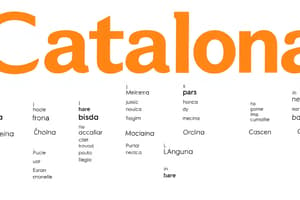Podcast
Questions and Answers
La dièresi s'utilitza per a indicar que la vocal "u" d'un dígraf "gü" o "qü" es pronuncia com a vocal oberta.
La dièresi s'utilitza per a indicar que la vocal "u" d'un dígraf "gü" o "qü" es pronuncia com a vocal oberta.
False (B)
Els verbs en forma [blank] no indiquen qui o què fa l'acció.
Els verbs en forma [blank] no indiquen qui o què fa l'acció.
no personal
Quin dels següents moviments artístics NO es considera una avantguarda?
Quin dels següents moviments artístics NO es considera una avantguarda?
- Barroc (correct)
- Surrealisme
- Cubisme
- Dadaisme
Quins són els elements principals que s'han de tenir en compte al fer un comentari de text?
Quins són els elements principals que s'han de tenir en compte al fer un comentari de text?
Connecta cada tipus de crònica amb el seu objectiu principal:
Connecta cada tipus de crònica amb el seu objectiu principal:
Flashcards
Acentuació
Acentuació
Regles que determinen on s'accentuen les paraules en català.
Dièresi
Dièresi
Sinal que indica que dues vocals contigües s'han de pronunciar separadament.
Formes no personals dels verbs
Formes no personals dels verbs
Variacions verbals que no indiquen una persona específica (infinitiu, gerundi, participi).
Avantguardes
Avantguardes
Signup and view all the flashcards
Comentari de text
Comentari de text
Signup and view all the flashcards
Study Notes
Acentuació i Dieresi
- Acentuació: Refers to the placement of accents on written words to indicate the syllable that receives stress or intonation. Rules vary, and can be important for correct pronunciation and meaning.
- Types of accents: Acute (´) , Grave (`) , and Circumflex (^). Each type has specific uses based on the syllable position and the vowel.
- Dieresis: A diacritic mark (¨) used over a vowel usually to indicate that both vowels are pronounced separately.
Verbs: Formes no personals
- Infinitive: The base form of the verb, indicating action or state of being. E.g., "amar," "comer," "ir."
- Gerund: Indicates an action in progress. Often ends in "-ando" or "-iendo." E.g., "comiendo," "trabajando."
- Participle: Indicates a completed action. Can be past or present and often functions as an adjective. E.g., "hablado" (spoken), "comido" (eaten).
- Imperfect Participle: A specific past participle used for some tenses.
Les Avantguardes
- Avant-garde movements in art and literature are characterized by a deliberate rejection of traditional styles and a pursuit of radical innovation.
- Key Characteristics: experimentation with form, content, and technique. Often influenced by social, political, and philosophical ideas of the time.
- Examples of movements: Cubism, Futurism, Surrealism and many others (including specific periods of a movement).
- Common Themes: Challenging traditional aesthetics and societal norms. Exploring new ways to convey feelings and perceptions.
- Impact: Created a profound shift in how art and literature were perceived and produced.
Comentari de text
- Commentary on a text requires critical analysis, interpretation and understanding of the text's themes, context, and style.
- Steps in commentary: Close reading to identify key elements (themes, figures of speech, rhetorical devices). Contextualization (historical, social, cultural background). Interpretation of the author's purpose and message. Support arguments with evidence from the text.
- Structure: Usually include an introduction (statement of purpose), body (analysis of specific aspects), and conclusion.
Crònica
- Crònica: A type of writing, typically journalistic, that chronicles events, offers commentary, and often includes a personal perspective or particular interpretation.
- Characteristics: Focus on current events or historically specific moments.
- Style: Varying in tone, ranging from objective reporting to subjective opinions.
- Examples of formats: news stories, detailed accounts of events, personal reflections.
Studying That Suits You
Use AI to generate personalized quizzes and flashcards to suit your learning preferences.




